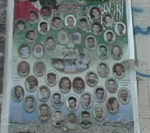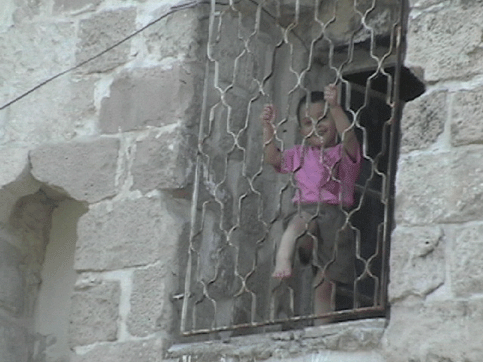The Electronic Intifada 6 May 2002

Camera: Arjan El Fassed & Annet Meeuws; Editing: Arjan El Fassed
SCREENSHOTS

Since the outbreak of the second Intifada posters of Palestinian martyrs are common on the walls of Palestinian towns. In Nablus, there is one poster, showing the names and faces of eight members of the Shubi family, that people stop to look at (Photo: AEF, 2002)
One can read the names and look at the faces of a family of eight killed on April 6, 2002, when a D9 Israeli army bulldozer toppled their home onto their heads. This portrait is surrounded by more than a dozen others on the poster, some of them resistance fighters but most of them civilians. Eight members of the Shubi family were killed, including three children, their pregnant mother and 85-year-old grandfather. Israeli forces failed to ensure that there were no people in the home when they demolished it.

“I saw one of the large bulldozers coming from the west side bulldozing the al-Shu’bi family house and I saw the house tilt over. Without even thinking, I yelled to the soldier in the bulldozer, ‘Let the residents leave the house.’ At this point the soldier came out of the bulldozer, took his weapon and started to fire in my direction. I moved out of the way and the bullets hit the wall of my house. You can still see the holes. At this moment, I told my children to leave the house and I told two other families nearby also to leave” (Photo: AEF, 2002)
Ahmad Fu’ad al-Najjar, a next-door neighbour of the Shubi family told Amnesty International:
“In previous incursions into the old city, the Israelis have used the area where we live as an entry point. The residents of this area knew this and knew that it could be dangerous. We were, as a result, in close contact with each other during this incursion. We kept alert as we anticipated danger. I had warned my other neighbours that this would be used as an entryway to the old city and we agreed amongst ourselves that we would warn each other if we suspected anything. On Thursday 4 April, I spoke with Samir al-Shu’bi and warned him of the danger. On Friday, Samir’s wife, Nabila yelled to me from a window at about 10am and said that there were many tanks behind the house and some bulldozers on the road. She said she could see them from her house. Behind the al-Shu’bi house there is a big open area where the tanks used to come and go. Things at that moment didn’t seem dangerous. On Saturday 6 April there was a lot of tank and bulldozer activity. On that day, I spoke with Nabila and she said that there were lots of bulldozers working but she didn’t know what they were doing. At about 7pm that night, the bulldozing of houses began.“I saw the bulldozing of the Ghanem house from my house. I saw Sulayman Ghanem and his wife on the street. I shouted to them from the window and asked if the rest of the neighbours had left. He told me his family had all left and I asked about the al-Shu’bi family and he said that he thought they had left as well. I then looked and I saw one of the large bulldozers coming from the west side bulldozing the al-Shu’bi family house and I saw the house tilt over. Without even thinking, I yelled to the soldier in the bulldozer, ‘Let the residents leave the house.’ At this point the soldier came out of the bulldozer, took his weapon and started to fire in my direction. I moved out of the way and the bullets hit the wall of my house. You can still see the holes. At this moment, I told my children to leave the house and I told two other families nearby also to leave. We headed for the mosque.’” - Shielded from scrutiny: IDF violations in Jenin and Nablus, Amnesty International, November 2002
No warnings were given before the Israeli forces began to destroy the homes. Residents were on such a high state of alert that if any warning had been given they would have left the area. On April 10, when the curfew was briefly lifted, neighbours started to come back into the area, they began to ask about the al-Shu’bi family.
Mahmud al-Shu’bi started to dig with the help of his neighbours, hoping to find survivors in the rubble. Because it started to rain, the mud made the process difficult. They carried on digging after the curfew was reimposed, and Israeli occupation forces fired warning shots in their direction several times. Late that night, the rescuers came across a small opening on the ground floor of where the house once stood; miraculously, in the small space that remained, were ‘Abdullah al-Shu’bi, 68, and his wife, Shamsa, 67, both of them alive. The rescuers went on digging throughout the night and came across the rest of the family huddled in a circle, in one small room: Mahmud al-Shu’bi’s father ‘Umar, 85; Mahmud’s sisters Fatima, 57; and ‘Abir, 38; Mahmud’s brother Samir, 48, and his 7-month pregnant wife, Nabila 40; and Samir and Nabila’s three children: ‘Abdallah, 9, ‘Azzam, 7, and Anas, 4. They were all dead.

Palestinian child in neighbouring home in the old city of Nablus (Photo: AEF, 2002)
Outside Nablus, few are aware of the killings that took place between April 4 and 21. The fighting here was the deadliest of the Israeli invasion of West Bank towns last month, and perhaps the bloodiest period in one locale since the uprising began in September 2000.
Related Links: